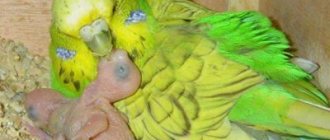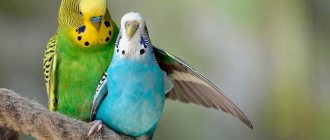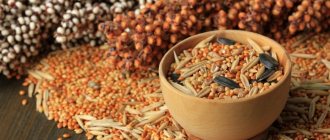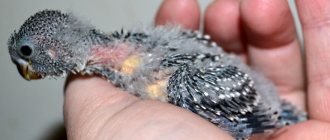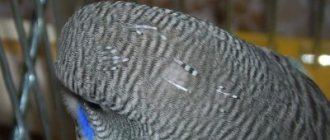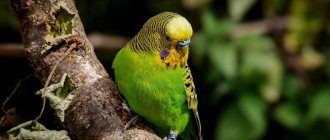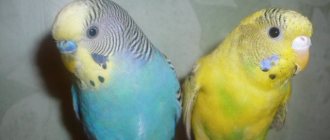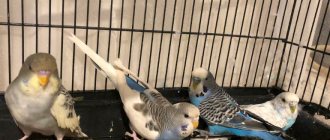Waiting for chicks from budgerigars is the cherished goal of novice breeders. Instincts help birds navigate this path, but there are situations when they cannot do without human intervention. Let us consider step by step the process of the appearance and development of chicks - from the moment of fertilization to the first flight.
Start of incubation
At the age of 8-9 months, the female budgerigar is ready to breed. To stimulate the sexual instinct, birds need an equipped place where they will lay eggs. Budgerigars do not build a nest, so the breeder puts a special house in their cage - a nest box. The expectant mother creates comfort in it: she brings pieces of paper, thin twigs, sawdust. From these materials the bird lays out a kind of nest, a soft bedding.
A few days after fertilization, the female settles into the nest house, preparing to lay an egg. The parrot's belly is noticeably rounded, its tail rhythmically swings up and down in time with its breathing. The female lays one egg per day. The average number of eggs in budgies is 6, in rare cases it is 10-12. The female cannot heat such a large clutch; not all eggs hatch into chicks.
Having laid 2-3 eggs, the female parrot fully sits on them, and from that moment the incubation period begins. After how many days it ends, it will become clear when the first newborn hatches. Normally, incubation lasts 18-28 days. During this period, the bird can leave the nest for a short time to empty its intestines, drink water, and stretch its legs. While the mother is absent, the eggs do not have time to cool to a critical temperature. Periodically, the parrot turns the eggs over, changing their places - thus, the embryos develop evenly.
Mating, laying and incubating eggs
In the wild, animals breed throughout the year, nestling in tree hollows. In captivity, pets need help by building a nest box. It is most advisable to install it after cold winter days, when procreation is also complicated by external seasonal factors.
The house for the future offspring of parrots will take pride of place in the cage, and the female will immediately begin arranging it to her liking. As soon as the design solutions take on a finished form, the period of kissing and mating games begins, which indicates that the spouses are ready for replenishment. It is recommended to mate pets when they reach one and a half years of age, otherwise the cubs risk being premature and sick, or even stillborn.
Usually, from the moment the nest appears, after 14 - 20 days, the first tenant appears in the house. After the second, the female begins to hatch them. A clutch usually contains from 4 to 12 eggs, and their appearance occurs at intervals of one or two days.
The appearance of chicks
The first chick appears in the nest 18-19 days after the start of incubation. You should not watch budgerigar chicks hatching, otherwise the female will become alarmed. The sacrament of birth occurs like this: cracks become visible on the shell, which gradually expand, and then the shell breaks in two. To crack the shell, the chick uses a bone growth on its beak - the so-called “egg tooth”. If the baby is weak, the female will help him break his way out of captivity.
Newborn chick
Important! With high air humidity, the birth process occurs much easier. If the room is too dry, the film shell sticks to the delicate skin, and only the new mother can free the baby.
The birds appear one after another, most often in the same order as the eggs were laid. The number of eggs determines how many days the chicks will hatch. If 4 weeks have passed since the start of nesting, the remaining eggs can be removed - they will no longer hatch into chicks.
"Portrait" from life: birth
So, the female laid several eggs in the nesting house and began to incubate them. After 19 days, the chick hatches from the first egg laid, and after a day or two, so to speak, in chronological order, the rest will begin to appear.
Newborn wavy chicks are born weighing literally 1-1.5 grams and look very unattractive and helpless: their pink-purple body is completely devoid of plumage, the future handsome ones have a disproportionately large head, which their long thin neck cannot even hold, and weak legs . Birds don't see or hear.
Reproduction of wavy birds.
Appearance of newborn chicks
A newly hatched chick looks completely different from its parents. You can’t immediately say that someday this helpless, naked and blind cub will become a beautiful wavy. In the first hours the baby weighs only 1-2 grams. He has no feathers, only individual fluffs. The legs and neck are thin, and the head, on the contrary, is disproportionately large. Because of this, the chick cannot move, it only fidgets a little, but over time it will gain strength.
Stages of growth of a parrot chick:
- After a week, vision and hearing appear.
- The egg tooth falls off.
- Movements become meaningful, the chick has better control of his body.
- Body weight is rapidly increasing.
- “Columns” of feathers grow on the head, back and wings.
- At three weeks the weight of the chick reaches approximately 40 grams.
After one month, the bird is practically formed in appearance. The body is covered with feathers, the tail is long, the wings are full, ready for the first flight.
We are growing by leaps and bounds
Hatched from the egg and went straight to his mother.
However, it is necessary to reassure the future owners of the wavy birds: they will not be like this for long. Around the 6th day, their egg tooth will fall off and they will be able to lift and hold their head up for a while. And after about a week or a little more, their eyes will open, the babies will even try to sit up on their own. After another couple of days, stumps—the “embryos” of feathers—will begin to appear on the back and head.
By the 11th–13th day, the birds are completely covered with fluff.
At two weeks of age, young wavy animals already weigh 10 times more than at birth.
Observations show that chicks grow most quickly in the first two weeks. And when the down and feather cover begins to form, their growth slows down somewhat.
The 17-18th day is marked by the fact that the flight feathers grow significantly, and the bodies of the chicks themselves are covered with stumps of covert feathers, which is why the birds acquire a resemblance to hedgehogs. By the end of the third week, real feathers appear on the back, head, and wings.
There is no need to panic, seeing that young parrots at this time become timid and immediately start squeaking when someone approaches the cage - this is a very crucial moment in their life.
On the 20th day, it becomes possible to determine what color the parrot will be.
Tail and flight feathers grow significantly on the 24th–26th day. And the one-month-old chicks have almost completely acquired their plumage and, with normal care, gain maximum weight.
When the chicks reach the age of 35 days, they can already pass for adult parrots, except that their movements are not yet entirely confident.
When does a budgie start flying? At 40 days, babies make their first attempts to fly.
It is interesting to watch how the chicks gain weight as they grow older. If immediately at birth, as already mentioned, they weigh 1-1.5 g, then already on the first day their weight doubles - 2-3 g. And then it looks something like this, given that the first number indicates normal weight, and the second is standard:
- The first feathers. third day - 5-6
- 6th — 10-11
- 9th – 17–20
- 15th – 31–45
- 20th – 39–52
- 24th - 42–57
- 30th – 40–45
Caring for budgerigar chicks
Taking care of children is the task of feathered parents. The mother warms and protects the offspring, turns them over, feeds them, and cleans them. At this time, the male continues to feed his partner, as she tries not to leave the nest.
The owner is required to provide comfort for adult budgies: clean the cage in a timely manner, add food and vitamins, and change the water. However, the breeder's responsibility does not end there. Sometimes you have to take on the functions of a nursing mother if the female is unable to raise the chicks - she gets sick or abandons the nest.
What to feed the chicks
From the first hour of life, the bird needs liquid food. Her body is not yet able to accept and digest dry food. A novice breeder has a reasonable question: what to feed the budgerigar chicks if they can’t even hold their heads up yet. Two feeding options are possible: a natural method, when the female produces provisions for children in her crop, or artificial - this is feeding through a tube, if maternal participation is impossible.
Natural feeding
The first food for chicks is crop milk, which appears in the female as a result of digestion of dry food. It looks like a yellowish mucous substance. The female regurgitates this liquid and feeds the babies from beak to beak. The feeding process takes almost all the time, but there is enough milk for everyone.
Further, when the growing cubs require more nutrition, the food in the female’s crop does not have time to be digested to a liquid consistency. The young animals receive softened grain in the same way - from the mother’s beak. At some stage, the father budgerigar joins in feeding the chicks and takes care of them along with the partner.
Artificial nutrition
When the natural course of events is disrupted, the responsibility for caring for the parrots passes to the breeder.
Reasons for transferring chicks to artificial feeding:
- The female abandons the nest or dies.
- Aggression towards cubs on the part of parents.
- Forced isolation, quarantine.
- Weak body.
- Large brood size.
- The female's readiness for new nesting.
Attention! The chick can live without food for the first 12 hours, during which time it is necessary to resolve the issue of feeding.
Every breeder should know how to feed a budgerigar chick that has lost its mother. If more than one pair of parrots lives at home, you can offer the babies to another female. Otherwise, you will have to save the situation yourself. To do this, you will need a cardboard box lined with sawdust or soft cloth. Newborns are placed there, and a homemade heating pad is also placed.
The next step is to prepare the feeding tube. It is made from a syringe and a flexible tube measuring 10 cm by 2.5 mm. The edges of the tube are processed, then food is drawn into the syringe and the tube is placed on the protrusion of the syringe. Nutritional paste is diluted from a dry mixture for chicks.
A homemade catheter is lowered into the open beak to a sufficient depth so that the mixture goes directly into the crop. Lightly press the piston and release a small portion of food. The chicks are fed this way every hour for the first 3-4 days; a longer break is possible at night. In the future, it will be enough to offer food once every two hours, but in an increased portion. Budgerigars grow very quickly, and at the age of 3 weeks they can already independently peck food from a spoon.
Mom's diet
When a female incubates eggs, she spends a lot of energy heating the clutch, and her body is exhausted. In order for the mother to produce adequate nutrition for the parrots, she herself needs to be well fed.
The bird's diet should include:
- sprouted wheat grains;
- milky oats;
- fresh greens.
Once or twice a week you can give the bird chopped egg white. Food of animal origin is rich in protein, which is necessary for the growth and development of chicks.
Creating a microclimate
While the budgerigar chicks are not overgrown with fluff and feathers, they need their mother's warmth. For the first four days, the offspring hides under the wings of the female and warms up from her body. As the young grow, they get used to a gradual decrease in temperature to 30-32ºC. Brooders - heating houses - help maintain the temperature. If it is not possible to keep the room warm or the chicks are left without a mother, you can use such a house.
Brooder
Nest care
The female and her newborns should not be disturbed for 10 days, and after this period it is necessary to clean the nesting house. The young animals are transplanted into a box, and their mother is also sent there. All waste products - droppings, leftover food, garbage - are removed from the house. Dirty litter should be thrown away and fresh sawdust put in its place.
If the parrots' feet are heavily soiled with droppings and stuck food, they need to be washed. This is done like this: pour warm water into a plastic container, and then take the chicks one by one and wash their paws. After washing, carefully blot the feet with a paper towel.
When can you switch to adult food?
By the seventh week of life, you can stop caring for the chicks. They eat on their own, become fully feathered, and attempt to fly. During this period, you should gradually add dry food to the diet, while not forgetting to give your pet water.
A sure sign that it’s time to switch to adult food is the bird’s confident grip . If the bird feels good on the perch or on the owner’s finger and does not lose its balance, then this means that the chick has matured.
Adult food also includes fruits and vegetables. You can no longer grind them into a pulp, but simply cut them into pieces. Mixtures in a liquid consistency are given to sick birds experiencing problems with the gastrointestinal tract or with a weak immune system.
Development of a budgerigar chick
The main stages of growing up a budgie:
- Newborn. Lasts from the first to the tenth day. The period ends with the loss of the egg tooth, the appearance of vision and hearing. Babies begin to raise and hold their heads and sit down on their paws.
- Second decade of life. The rudiments of feathers grow, body weight increases to 40 g.
- Third decade. The flight and tail feathers grow back and a wavy pattern appears. The cere is painted a certain color, depending on the sex.
After reaching the age of one month, the young individual looks like an adult parrot. The chick in it is revealed by its carefree character and dark eyes without rims. At this time, the parrot tries to take off, but cannot coordinate its movements and often falls.
Important point! The first flight from the nesting house is dangerous for a bird due to injury, so before the experiments begin, the chicks need to be moved to a separate housing.
Useful tips
If the cage acts as an incubator, then the drinking bowl and bathing bowl must be removed from it. Small chicks may accidentally choke or drown in containers. Any sharp objects or abrasive elements, such as concrete perches, should also be removed to prevent injury.
Recommendations for beginners:
There is no point in stocking up on mixtures for future use. The dose per chick is about 5 ml. Natural liquid food spoils very quickly, and sour food can cause serious poisoning.- There is no need to feed the young animals. The chick will receive the required amount of water along with cereals and other liquid food.
- Starting from the seventh day of life, the pet’s diet must be diversified with fruit juices. If you’re too lazy to cook them yourself, you can buy baby food.
- Birds need minerals to strengthen their bones. You can find them in eggshells and chalk. But the main thing here is not to overdo it, because an excess of minerals will have a detrimental effect on your pet’s health.
How to find out gender
In budgerigars, gender is determined by the color of the wax - a growth above the beak. It is possible to find out what sex the chick is no earlier than four weeks of age. Moreover, it will not be possible to do this the first time, since at different times of the day the cere of a budgerigar chick can change color.
The following colors are typical for boys:
- light purple in a representative of natural color;
- purple or pink in the selection specimen.
In the early period, the boy is identified by bluish rims around the nostrils or the absence of them. It is known that in girls these rims are white, and the wax itself is blue.
After the first moult, it is much easier to find out the sex of the bird: females have a beige or brown wax, while males have a blue one. And the older the individual, the brighter the shade.
There are several other methods for determining sex: behavioral, based on feather color, genetic, DNA analysis. Experienced breeders know how to determine the sex of a parrot by external signs, without resorting to complex laboratory diagnostics.
The chick died. Why?
It always hurts a lot when you find a dead chick in a nest. Nothing seemed to foretell trouble. There are several reasons for the death of newborns:
- lack of food;
- hypothermia;
- underfeeding or mother abandoning offspring;
- aggressive attitude of one of the parents;
- an inexperienced mother could accidentally crush the baby;
- attack by a female ready for a new clutch.
Why can a parrot die?
A person who is going to seriously engage in breeding budgies at home must realistically imagine all the difficulties and pitfalls of this business in order for it to be successful.
How to tame a chick
Raising a budgie should be done after it is removed from its parents. For a parrot, a chick is the most precious thing in life. If you try to tame the chick earlier, the female will rush to protect it. In addition, at a young age, the wavy is attached to its mother; it doesn’t need anyone else.
When small pets take up a new place of residence, it is easier to find an approach to them. At first, try to appear near the cage only to change water and food. Watch how the birds react to you. Having noticed that the birds get used to it and behave calmly in the presence of a person, begin to address them kindly. Offer your parrot a piece of fruit on a skewer.
After some time, you can move on to closer communication. Open the door and extend your palm with the treat on it. The emboldened chick will fly up and sit on your hand. Just don’t scare him, don’t make sudden movements.
Do not let your budgies out of their cage while they are still small. They will be afraid to return on their own; they will have to catch them. Let the first flight take place when the bird learns to sit on your shoulder. In this case, the taming process is not threatened.
Reproduction at home: pros and cons
Breeding parrots can be for fun or as a business idea, that is, for the purpose of making a profit.
Pros and cons of breeding parrots at home
In both cases, this is a fascinating activity that requires a responsible attitude and patience on the part of the bird owner. You need to carefully weigh the pros and cons before you seriously engage in breeding work.
If we compare breeding parrots with raising other birds, such as pheasants, quails or chickens, the variety of species makes them more versatile. The size of many of them allows you to keep pets in a city apartment without the need to live in a rural area.
The high cost of exotic birds can be considered a plus. And cheaper types pay off due to the high demand for them. We are also pleased with the fertility of parrots, which retain the ability to reproduce all year round. Igor Ignatenkov
The favorites of small and medium-sized species are especially good at this, for example, wavy birds, cockatiels, and lovebirds. Difficulties may arise with large birds, the breeding of which requires certain skills and living conditions.
It is also worth noting the amazing intelligence and friendly nature of the pets, working with which will bring a lot of joy to their owner.
How do parrots reproduce?
The disadvantages include the noisiness of birds. Some species emit sharp, unpleasant screams, which is why not every person can tolerate being in their proximity.
Before you start breeding parrots, you need to take into account the time costs of maintaining them. Bird breeding can be done by people who are willing to devote enough energy to caring for their pets.
Read also
Lovebird parrots care and maintenance at home for beginners
It is necessary to maintain cleanliness in the cages, feed and water the pets on time, educate, train them, and treat sick individuals. When the chicks appear, the parrots will require even more care. You will also need to take care of the future fate of the kids and find them a new home.
Causes of sudden death of chicks
Newborn chicks are very fragile, they can die unexpectedly and suddenly. Many chicks inherit genetic pathologies from their parents that are incompatible with life.
Other causes of infant mortality in budgerigars:
- the female does not have time to fully feed the entire brood;
- the weak chick was crushed by the mother out of inexperience;
- the female abandons the nest after incubating the eggs;
- aggression of the mother or father towards the cubs;
- unsuccessful flight from the nesting house.
There is constant opposition between chicks of the same brood - competition for food, warmth, and better conditions. If an individual is weakened, it can simply be crushed in a crowd.
Budgerigars have offspring quite often - about 2-3 times a year. These birds readily breed in captivity. The feathered parents cope well with their natural role, but in difficult situations the breeder is always ready to help.
Possible mistakes
Beginning hobbyists, and sometimes even an experienced breeder, may encounter a number of problems when breeding birds. Errors occur when selecting a pair and determining the sex of birds, preparing the diet of pets, and creating conditions for reproduction.
Why don't budgies reproduce?
Below are the most common reasons for unsuccessful breeding of parrots
- A pair of birds are constantly quarreling. This behavior is possible if the birds in the cage are of the same sex, or one of the individuals has been kept alone for a long time, or the pets simply do not “like” each other.
- Showing and even mating are observed, but parrots do not lay eggs. It is likely that both individuals are males or one of the birds is immature.
- The female sits on the eggs, but the chicks do not hatch. This phenomenon occurs when the eggs are unfertilized, the parents are too old or infertile, or both parrots are female.
- The brood dies. The reason may be the loss of parental instincts in birds, when they do not feed their babies or even deliberately injure them. It is possible that the body of the breeding birds is exhausted. This happens if the brood is already the fourth or more this year. Some species are also predisposed to such behavior, for example, the Czech parrot.
HOW DIFFICULT IS IT BREEDING Cockatiels at Home?
Signs of preparation for masonry
By carefully observing his pets, the owner can determine the beginning of preparation for laying by certain signs: the birds are courting each other, taking proud poses, jumping, flapping their wings, and making guttural sounds.
It is very interesting to watch a male courtship with his girlfriend. He circles around her, feeds her, makes all sorts of calling sounds and nods his head excitedly. The female, in turn, is not at all against such signs of attention, does not object and begins to regularly visit the house. At first she is interested in the house from a distance and examines it, craning her neck. Then he comes closer, picks it with his beak, can jump into it, stay there for a while and jump out. Every day the female will spend more and more time there. You will hear her scratching something with her paws or gnawing on a tree. The female gets used to the fact that she will have to spend a long time in the nest.
In the video you can watch how a male budgerigar shows signs of attention and cares for a female.
Types of food
There are several types of feeding for newly hatched wavy birds.
Use of a donor bird
This method is used by experienced breeders who are professionally involved in breeding birds. The grain mixture is fed into the parrot's crop through a catheter, from where the digested form is sucked out by a probe. A dangerous, but the most effective type of food for artificial birds, while all the substances necessary for life will be supplied to the bird’s body.
Feeding malt milk
Malt is prepared from sprouted grains, crushed, filtered, mixed with water and egg until a paste-like consistency is obtained. Feed warmed up to 39 °C. At a lower temperature, the mixture is not digested, it begins to ferment in the goiter, and the bird dies of hunger. Higher food temperatures cause burns.
Porridges with added enzymes
You can feed the wavy with porridge by mixing mezim or festal. The exact dosage of the drugs should be observed; it is advisable to use it with malt milk.
Feeding with ready-made formulas
The most convenient way to feed chicks. Special branded balanced ready-made feeds of good quality, for example, NutriBird A19 and A21, are diluted with warm water to the required density, taking into account the age of the young animals, and fed to babies. With this daily diet, birds receive the necessary components: lactobacilli, enzymes, nutrients for promoting health and growth, similar to those produced by the mother's crop.
Dairy-free porridge
Buckwheat, oatmeal or corn porridge is cooked without milk, salt and sugar. You can feed the birds with dairy-free rice porridge. From the third day of life, the menu includes vegetable juices from carrots, pumpkin or beets. You can add a piece of egg yolk, pureed through a sieve. From the tenth day, fruits are added: banana, apple, low-fat cottage cheese.
On the twentieth day, the little bird begins to be fed from a spoon, and tries to feed itself, offering the budgie crushed sprouted grain.
From the age of thirty days, whole grains begin to be introduced. Even if there is no one to show how to eat it, after a while the chicks will learn to peck on their own.
When feeding birds with liquid porridges and mixtures, there is no need for water, with the exception of hot days. Over time, when the bird grows up and begins to feed on its own, clean filtered water should be in the drinking bowl at all times.
What should a cell be like?
For one pair of birds, a cage measuring 60*40*40 cm is suitable, for two pairs - twice as large. The design of the cage should be simple, made of durable material. It is desirable that the bottom of the cage extends, and it is possible to attach a nesting house to the side panels.
There are three types of bird houses: vertical house, horizontal house and compromise house. Whatever type of house you choose, it must have a folding or removable roof. This is necessary for timely inspection of the masonry, cleaning and disinfection of the nest.
Did you know? Budgerigars colonized Australia 5,000,000 years ago, during which time 200 species of these birds have survived.

